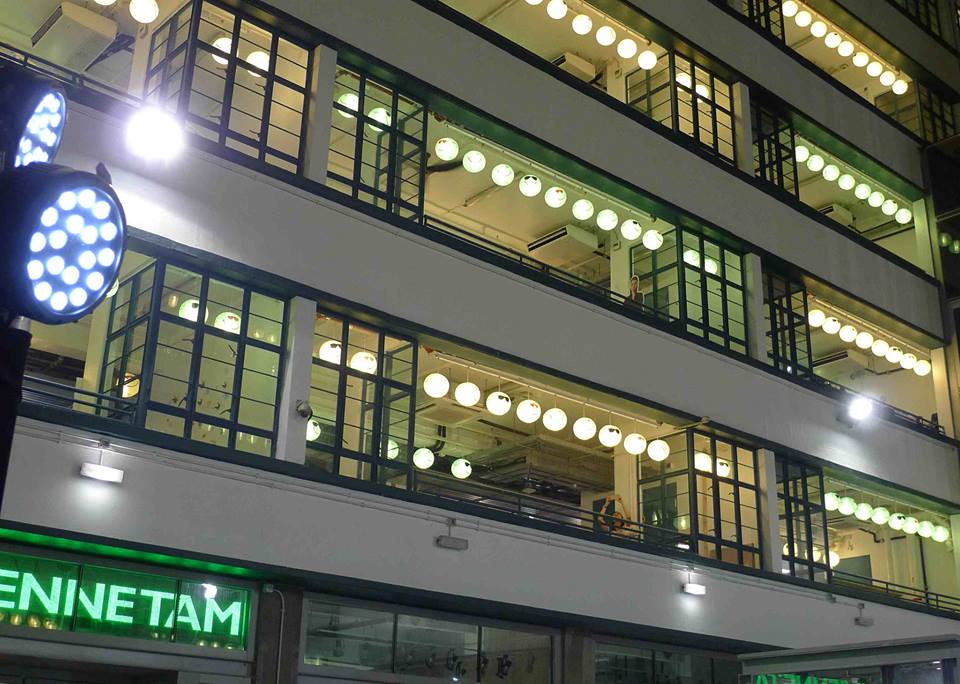Reviews & Articles
不要另一個元創方 ∣ Not Another PMQ
John BATTEN
at 2:43pm on 23rd August 2016


Images: GP Battery promotion during Mid-Autumn Festival 2015.
(Please scroll down for English version.)
報章最近有不少元創方的報導。它的營運者是非牟利組織同心教育文化慈善基金會,在香港設計中心、香港理工大學和職業訓練局轄下的香港知專設計學院的協辦下,獲政府批准以「標誌性的創意中心」營運。新聞聚焦在上市公司金山工業主席羅仲榮身上,還涉及他的家人和其他在元創方經營的商號。2016年4月前,羅仲榮任香港設計中心主席多年,也是西九文化區管理局董事局成員和前行政會議成員。他的媳婦是Aberdeen Street Social的合夥人,那是其中一家在元創方經營的食肆。
元創方的前身是荷李活道已婚警察宿舍,是一片公共用地,政府在2005年把它納入出售之列。這個地點是中西區關注組發起的首個保育及規劃項目。我們最初的目標是阻止該區過度發展,因為區內本來已受交通擠塞、路邊污染和缺乏社區設施影響,不適合再增建多幢高樓大廈。然而,隨著我們的運動推進,我們開始明白這裡的重要歷史,奇怪的是當時政府部門或有關物業出售的討論均完全沒有提及這方面資料。
這裡是中區其中一個最古老的住宅地段,在香港殖民時代前曾建有一座城隍廟,到了1840年代後,開始出現民房,該區曾被街坊稱為「卅間」,叫法時至今日仍然沿用。每年在鴨巴甸街和士丹頓街交界舉辦盂蘭勝會的街坊組織,便是以「卅間」為名。但更重要的,是整個社區是現代中國革命的搖籃:孫中山和辛亥革命的領袖就是在這區內擬定推翻滿清政府的大計。
中央書院是香港首間公立學校,孫中山於1884 1886年在該校就讀。1889年,中央書院由歌賦街遷至這位於荷李活道及鴨巴甸街交界的新校舍,並於1894年易名皇仁書院,直至1941年被日軍佔領前,這座美麗的維多利亞式建築物一直都是該校的家。到了1945年英國人重新取回這用地時,建築物已被嚴重損毀,皇仁書院於是遷往堅尼地道,不久再搬到天后的現址。舊建築移除後,這裡於1951年建成兩座宿舍大樓,在學校原有地基上採用了現代主義設計,並保留了皇仁書院的石圍欄。兩座大樓名為「亞裔警員宿舍」,原為當時受聘於殖民地警隊的印度裔警員提供住宿,宿舍每層兩端設有共用的衛浴設施。
簡約是這兩幢現代主義建築的其中一項優點:建築工程簡便,設有長而寬闊的開放式走廊,為沒有空氣調節的住宅單位提供良好的通風,兩座之間的空地則可以作公共休憩用。它的設計是香港公共屋邨的重要前驅與模範,類似的設計特式可以在仍然屹立的石硤尾美荷樓可見。美荷樓是1953年石硤尾大火後建成的首批公共屋邨中仍然保留的一幢。香港的住屋短缺問題,隨著1948年後大量中國難民湧至後加劇,這也影響了警員的住屋供應。在1950年代初,這兩幢宿舍成為已婚警員和他們的家人的居所,露台位置後來更改裝成獨立衛浴設施。2000年宿舍開始空置。
中西區關注組於2005年至2008年間全力爭取保育宿舍及中央書院遺跡,包括兩次向城規會提出申請、游說立法會議員與政府官員、為傳媒提供資訊,以及號召公眾爭取保育上址和建築群作社區用途。當局最終在推出「保育中環」計劃時𠄘諾保育這用地,回應了公眾希望更好保護香港有限的文物建築的訴求。
我們對這用地的基本建議,是以其中一幢作為青年宿舍,而另一幢則用作不同界別的駐場藝術家計劃,前警訊少年會所可以開設茶餐廳,空地可以提供戶外社區休憩用地、種種草木,加設一個安全的兒童遊樂場。這個計劃只需小額投資,因為兩幢建築物只需要基本的修葺 ,並沒有像現時由政府支付,以高價建造的「多用途會堂」,又或後來加建的一層作食肆用途,這些都是同心基金的建議。我們認為鄰近的蘇豪區已有足夠的飲食地點,可以配合宿舍改建後的新用途。
在同心基金經營,以及其支援夥伴的影響下,很多人感慨元創方已演變成一個售賣設計師產品、品牌與精品食肆匯聚的商場,有點像尖沙咀的海港城!這種經營模式可以為誰帶來利益可堪爭議,政府或可於租約在2023年完結時作檢討。但大家已得到教訓,在中區警署成為「大館」的規劃而言,願景是「不要成為另一個元創方」 – 那裡應該是黃大仙陳生陳太一家都同樣歡迎的地方!
原文刊於《明報周刊》,2016年7月30日。中文翻譯: Aulina Chan。
'Not Another PMQ'
by John Batten
PMQ has been in the news recently. Its operator, the non-profit organization, the Musketeers Foundation - supported by the Hong Kong Design Centre, the Hong Kong Polytechnic University and Hong Kong Design Institute of the Vocational Training Council - was chosen by the government to operate the site as a “creative industries landmark.” News reports focused on links that businessman Victor Lo, Chairman of Hong Kong Stock Exchange listed Gold Peak Industries, and his family and other business entities had businesses operating at PMQ. Until April 2016, Victor Lo was the long-time Chairman of the Hong Kong Design Centre; he is on the Board of the West Kowloon Cultural District and a former Executive Councillor. His daughter-in-law is a partner in Aberdeen Social, one of the restaurants operating in PMQ.
PMQ is sited on the Former Police Married Quarters in Central. It is a publicly owned property and in 2005, the government listed it for sale. This site was the first heritage conservation and urban planning campaign that the Central & Western Concern Group mounted. Our aim was to halt another inappropriate high-rise development in an area severely affected by traffic congestion, roadside pollution, and a lack of community facilities. However, as our campaign progressed we began to understand the site’s significant history, of which nothing had been mentioned by any government department or discussed in relation to the sale of the property.
The site is one of the oldest occupied pieces of land in the Central district. It was the site of Hong Kong’s pre-colonial city temple, and after the 1840s there were shops on the site: the area was colloquially known as the ‘30 Shops’ area and even today, this reference is still alive. The local kaifong group that organizes the annual, elaborate Hungry Ghost Festival on the corner of Aberdeen Street and Staunton Street still uses the ’30 Shops’ nomenclature in its organisation’s name. But most significantly, the entire area is the revolutionary cradle for modern China – Sun Yat-sen and leaders of the Republican movement planned the overthrow of the Qing Dynasty from this very area.
Central School was Hong Kong’s first public school and was attended by Sun Yat-sen between 1884-1886. Needing more space, Central School moved across the road to the current PMQ site in 1889. In 1894, the school was renamed Queen’s College and its beautiful Victorian building was the school’s home until used by Japanese forces in 1941. The site suffered heavy bombing when Hong Kong was re-occupied by the British in 1945 and Queen’s College relocated, with a short period on Kennedy Road, to its current location in Tin Hau. The site was cleared and in 1951 two new residential blocks were completed using a functional modernist design built on the foundations of the school and retaining the original Queen’s College stone fence. Named the ‘Asiatic Police Quarters,’ its original use was to provide dormitory accommodation with shared toilet and washing facilities at the ends of each floor for Indian policeman, who were employed at the time by the colonial police force.
One of the architectural merits of this modernist design was its simplicity: easily constructed with long, open corridors allowing free passage and good airflow to the (unconditioned) living units with public recreation areas in the open space between the two blocks. This design was an important precursor and model for Hong Kong’s public housing and the design similarities of PMQ can be seen in the surviving Mei Ho House in Shek Kip Mei, the only surviving example of the original public housing built after the 1953 Shek Kip Mei fire. Hong Kong’s housing shortage was exacerbated with the influx of refugees from China into Hong Kong after 1948, and this also affected the police. In the early 1950s, non-commissioned married police officers and their families were housed in the two blocks, with balconies remodeled to provide individual toilet and washing facilities. Police use of the site as staff quarters ended in 2000. Little of this rich history is adequately explained to visitors walking around PMQ.
From 2005 to 2008 the Central & Western Concern Group ran a spirited preservation campaign that included making two applications with the Town Planning Board, lobbying the Legislative Council and government officials, supplying information to the media and rallying the public to retain the site and its buildings for community use. The government eventually agreed to preserve the site in its new ‘Conserving Central’ policy – an inspired decision responding to community concerns for better protection of Hong Kong’s limited built heritage.
Our suggestion for the saved site: basically, one block would be a youth hostel and the other block would house a multidisciplinary artists’ residency programme, with the former Police Call Centre becoming a chan cha teng and the site’s open spaces providing outdoor community sitting areas, grass, trees and a safe, enclosed children’s playground. This plan would require little capital investment as the two blocks would require only minimal renovation – there was to be no costly construction, paid for by government, of a ‘multi-function hall’ and adding another floor for a restaurant - as later transpired with the Musketeers Foundation proposal. We argued that nearby SOHO had enough food and beverage outlets to complement the site’s new uses.
Under the Musketeers Foundation, and the influence of its supporting partners, PMQ has - as many people, including designers, lament - evolved into a shopping mall for designer products, brand names and signature restaurants. It is similar to shopping at Harbour City in Tsim Sha Tsui! It is arguable who benefits from the current operation model – which will be reviewed by government after the tenancy agreement expires in 2023. But, lessons have been learned: in the planning of Tai Kwun at the Central Police Station, the idea is “To not be another PMQ – Mr and Mrs Chan and family from Wong Tai Sin will be very welcome!”
Originally published in Ming Pao Weekly on 30 July 2016. Chinese translation by Aulina Chan.
